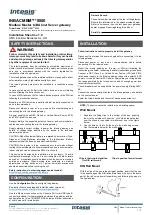
APPENDICES
© 1985, 1986, 1987 E-mu Systems, Inc. Page 218
APPENDIX A: GLOSSARY OF TERMS
ADSR:
Acronym for Attack/Decay/Sustain/Release, a particular type of envelope generator.
Analog synthesizer:
A type of musical instrument that synthesizes sounds from component
parts rather than via sampling.
Arpeggiator:
A circuit that plays notes sequentially for as long as they are held down.
Bounce:
When recording or sequencing, to “bounce” tracks means to combine several tracks
together on a single track.
Cent:
Unit of pitch equal to 1/100th of a semitone.
Channel, Output:
The circuitry through which the Emulator II outputs individual notes.
Channel, MIDI:
An “information pipeline” through which MIDI information is sent. MIDI provides
for 16 available channels, each of which can address one MIDI instrument.
Channel, MIDI Control:
A MIDI Channel also contains information about which controllers are
being varied. Assigning an Emulator II real time control destination to MIDI Control Channel A,
B, or C lets another MIDI device’s controllers control the Emulator II real time control
destinations via the Control Channels.
Cutoff Frequency:
The frequency above which a low pass filter will start attenuating signals
present at its input. Abbreviated Fc.
Data:
Information a computer needs in order to make decisions or carry out a particular action.
dB/octave:
The unit typically used to indicate the slope of a filter, or how fast the frequency
response rolls off past the cutoff frequency. Example: A 24 db/octave filter would attenuate an
input signal by 24 dB one octave above the cutoff frequency, by 48 dB two octaves above the
cutoff frequency, and so on.
Envelope Generator:
A circuit, usually triggered by pressing a keyboard key that generates a
changing voltage with respect to time. This voltage typically controls a VCF or VCA. An ADSR
envelope has four adjustable parameters: attack (the time required to go from minimum to
maximum voltage), decay (the time required to go from maximum voltage to a specified sustain
level voltage); sustain (the level at which the voltage holds during a keyboard key depression),
and release (once a key has been released, the time required to go from the sustain voltage to
minimum voltage).
Fc:
See Cutoff Frequency.
Filter:
A circuit that restricts frequency response, thus altering a signal’s harmonic structure.
LFO:
Low Frequency Oscillator. A circuit that is usually used to vary sound parameters at a
specific, low frequency rate. Example: Varying pitch cyclically creates vibrato.
Summary of Contents for EII+
Page 11: ...INTRODUCTION 1985 1986 1987 E mu Systems Inc Page 11 INTRODUCTION ...
Page 20: ...INTRODUCTION 1985 1986 1987 E mu Systems Inc Page 20 ...
Page 26: ...THE GUIDED TOURS 1985 1986 1987 E mu Systems Inc Page 26 THE GUIDED TOURS ...
Page 84: ...VOICE DEFINITION MODULE 1985 1986 1987 E mu Systems Inc Page 84 Fig VDEF 8 Fig VDEF 9 ...
Page 118: ...PRESET DEFINITION MODULE 1985 1986 1987 E mu Systems Inc Page 118 ...
Page 168: ...ENTER MODULE 1985 1986 1987 E mu Systems Inc Page 168 ENTER MODULE ...
Page 214: ...SMPTE SUPPLEMENT 1985 1986 1987 E mu Systems Inc Page 214 SMPTE SUPPLEMENT OVERVIEW PROTOCOL ...









































